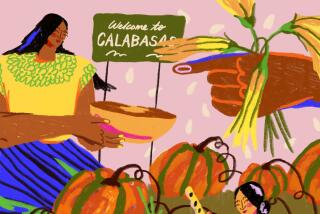The Peanut’s Pilgrimage
- Share via
Everybody knows the old-fashioned Southern name for the peanut is “goober,” and a lot of people are aware that “goober” is an African word, because the peanut was introduced to the South by the African slaves. But what’s going on here? The peanut isn’t native to Africa either; it was domesticated about 4,000 years ago in South America, in the foothills of the Andes somewhere around the border between Bolivia and Argentina.
Here’s what happened. The Portuguese encountered peanuts in the Caribbean and introduced them to West Africa in the early 1500s. Everywhere else in the world, people had a problem with idea of a plant that buries its seed pods in the ground (in the hope of protecting them from being eaten by, frankly, creatures like us), but Africa welcomed the peanut with open arms, because it already had several other crops that did the same thing.
The main one was Voandzeia subterranea, also known as the Bambara groundnut. A medieval Arab traveler described it as a sort of fava bean which people extracted from the ground and toasted or ground to a paste and made into cakes that were fried in oil.
When the peanut showed up in Africa, there was no contest. It was much easier to use than Voandzeia, which has a hard and woody seed, and much richer; a peanut is up to 50% oil, while the groundnut is only 8%.
So in most parts of Africa, the peanut just moved into Voandzeia’s old slot, being toasted and ground the same way, even being fried in cakes (after most of the oil has been pressed out). And it took over the old words for Voandzeia: gujiya in the Hausa language of Nigeria, njugu in Swahili . . . and in the Kikongo language of Zaire, nguba.
Or as we call it in this country, goober.
More to Read
Sign up for The Wild
We’ll help you find the best places to hike, bike and run, as well as the perfect silent spots for meditation and yoga.
You may occasionally receive promotional content from the Los Angeles Times.






